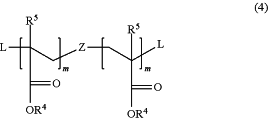| CPC C08L 83/04 (2013.01) [C08K 5/17 (2013.01); C09D 183/04 (2013.01); C09J 183/04 (2013.01)] | 5 Claims |
|
1. A method for preparing a polymer having a reactive silicon-containing group, comprising:
reacting a poly(meth)acrylate compound having the average structural formula (4):
 wherein
R4 is a substituted or unsubstituted C1-C10 alkyl group, or substituted or unsubstituted C6-C10 aryl group,
R5 is hydrogen or methyl,
Z is a single bond, substituted or unsubstituted C1-C20 alkylene group, substituted or unsubstituted C7-C20 aralkylene group, or substituted or unsubstituted C6-C20 arylene group,
m is each independently a number of at least 1, and
L is a leaving group selected from among chlorine, bromine, iodine, methansulfonate, trifluoromethanesulfonate, and p-toluenesulfonate,
with a compound having the formula (5):
 wherein R1 and R2 are as defined above,
R6 is a group containing a functional group capable of reacting with the leaving group;
wherein the polymer having the reactive silicon-containing group is represented by the structural formula (1):
 wherein R1 is a substituted or unsubstituted C1-C10 alkyl group or substituted or unsubstituted C6-C10 aryl group,
R2 is each independently a substituted or unsubstituted C1-C10 alkyl group or substituted or unsubstituted C6-C10 aryl group,
n indicative of the valence of X is a number of 1 to 3,
X is a mono- to trivalent organic group having a backbone skeleton selected from among polyurethane, polyurea, polycarbonate, polyester, polyamide, polyimide, polyamide-imide, poly(meth)acrylate, polystyrene, polyolefin, polyvinyl ester, polytetrafluoroethylene, polyacetal, polyphenylene ether, polyphenylene sulfide, polysulfone, polyether sulfone, polyether ether ketone, polysiloxane, polysiloxane-polyurethane copolymers and polysiloxane-polyurea copolymers, and copolymers thereof,
Y is a single bond, O, S, or N(R3),
R3 is hydrogen, a substituted or unsubstituted C1-C10 alkyl group, or substituted or unsubstituted C6-C10 aryl group, and when X is di- or trivalent, R3 in two groups N(R3) may bond together to form a substituted or unsubstituted C1-C10 alkylene group or substituted or unsubstituted C6-C2M arylene group, and
A1 and A2 are each independently a single bond, a substituted or unsubstituted C1-C20 divalent hydrocarbon group, or a divalent linking group containing a heteroatom,
with the proviso that when Y is a single bond, divalent group A1-A2 or X bonds to the Si-bonded CH2 group (excluding CH2 in R2) via a heteroatom.
|